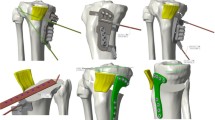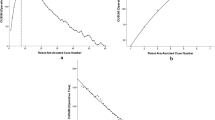Abstract
Purpose
Patient-specific cutting guides (PSCGs) have been advocated to improve the accuracy of deformity correction in opening-wedge high-tibial osteotomies (HTO). It was hypothesized that PSCGs for HTO would have a short learning curve. Therefore, the goals of this study were to determine the surgeons learning curve for PSCGs used for opening-wedge HTO assessing: the operating time, surgeons comfort levels, number of fluoroscopic images, accuracy of post-operative limb alignment and functional outcomes.
Methods
This prospective cohort study included 71 consecutive opening-wedge HTO with PSCGs performed by three different surgeons with different experiences. The operating time, the surgeon’s anxiety levels evaluated using the Spielberger State-Trait Anxiety Inventory (STAI), the number of fluoroscopic images was systematically and prospectively collected. The accuracy of the postoperative alignment was defined by the difference between the preoperative targeted correction and the final post-operative correction both measured on standardized CT-scans using the same protocol (ΔHKA, ΔMPTA, ΔPPTA). Functional outcomes were evaluated at 1 year using the different sub-scores of the KOOS. Cumulative summation (CUSUM) analyses were used to assess learning curves.
Results
The use of PSCGs in HTO surgery was associated with a learning curve of 10 cases to optimize operative time (mean operative time 26.3 min ± 8.8), 8 cases to lessen surgeon anxiety levels, and 9 cases to decrease the number of fluoroscopic images to an average of 4.3 ± 1.2. Cumulative PSCGs experience did not affect accuracy of post-operative limb alignment with a mean: ΔHKA = 1.0° ± 1.0°, ΔMPTA = 0.5° ± 0.6° and ΔPPTA = 0.4° ± 0.8°. No significant difference was observed between the three surgeons for these three parameters. There was no statistical correlation between the number of procedures performed and the patient’s functional outcomes.
Conclusion
The use of PSCGs requires a short learning curve to optimize operating time, reduce the use of fluoroscopy and lessen surgeon’s anxiety levels. Additionally, this learning phase does not affect the accuracy of the postoperative correction and the functional results at 1 year.
Level of evidence
II: prospective observational study.





Similar content being viewed by others
References
Ahlbäck S, Rydberg J (1980) X-ray classification and examination technics in gonarthrosis. Lakartidningen 77(2091–2093):2096
Arnal-Burró J, Pérez-Mañanes R, Gallo-Del-Valle E, Igualada-Blazquez C, Cuervas-Mons M, Vaquero-Martín J (2017) Three dimensional-printed patient-specific cutting guides for femoral varization osteotomy: do it yourself. Knee 24:1359–1368
Asik M, Sen C, Kilic B, Goksan SB, Ciftci F, Taser OF (2006) High tibial osteotomy with Puddu plate for the treatment of varus gonarthrosis. Knee Surg Sports Traumatol Arthrosc 14:948–954
Banerjee S, Faizan A, Nevelos J, Kreuzer S, Burgkart R, Harwin SF, Mont MA (2014) Innovations in hip arthroplasty three-dimensional modeling and analytical technology (SOMA). Surg Technol Int 24:288–294
Boonen B, Kerens B, Schotanus MGM, Emans P, Jong B, Kort NP (2016) Inter-observer reliability of measurements performed on digital long-leg standing radiographs and assessment of validity compared to 3D CT-scan. Knee 23:20–24
Brouwer RW, Bierma-Zeinstra SMA, van Raaij TM, Verhaar JaN (2006) Osteotomy for medial compartment arthritis of the knee using a closing wedge or an opening wedge controlled by a Puddu plate. A one-year randomised, controlled study. J Bone Joint Surg Br 88:1454–1459
Corona PS, Vicente M, Tetsworth K, Glatt V (2018) Preliminary results using patient-specific 3d printed models to improve preoperative planning for correction of post-traumatic tibial deformities with circular frames. Injury 49(Suppl 2):S51–S59
Dessyn E, Sharma A, Donnez M, Chabrand P, Ehlinger M, Argenson J-N, Parratte S, Ollivier M (2019) Adding a protective K-wire during opening high tibial osteotomy increases lateral hinge resistance to fracture. Knee Surg Sports Traumatol Arthrosc. https://doi.org/10.1007/s00167-019-05404-7
Donnez M, Ollivier M, Munier M, Berton P, Podgorski J-P, Chabrand P, Parratte S (2018) Are three-dimensional patient-specific cutting guides for open wedge high tibial osteotomy accurate? An in vitro study. J Orthop Surg Res 13:171
Duivenvoorden T, Brouwer RW, Baan A, Bos PK, Reijman M, Bierma-Zeinstra SMA, Verhaar JaN (2014) Comparison of closing-wedge and opening-wedge high tibial osteotomy for medial compartment osteoarthritis of the knee: a randomized controlled trial with a six-year follow-up. J Bone Joint Surg Am 96:1425–1432
Hankemeier S, Hufner T, Wang G, Kendoff D, Zeichen J, Zheng G, Krettek C (2006) Navigated open-wedge high tibial osteotomy: advantages and disadvantages compared to the conventional technique in a cadaver study. Knee Surg Sports Traumatol Arthrosc 14:917–921
Hantes ME, Natsaridis P, Koutalos AA, Ono Y, Doxariotis N, Malizos KN (2018) Satisfactory functional and radiological outcomes can be expected in young patients under 45 years old after open wedge high tibial osteotomy in a long-term follow-up. Knee Surg Sports Traumatol Arthrosc 26:3199–3205
Jacquet C, Chan-Yu-Kin J, Sharma A, Argenson J-N, Parratte S, Ollivier M (2018) More accurate correction using “patient-specific” cutting guides in opening wedge distal femur varization osteotomies. Int Orthop. https://doi.org/10.1007/s00264-018-4207-1
Jud L, Fürnstahl P, Vlachopoulos L, Götschi T, Leoty LC, Fucentese SF (2019) Malpositioning of patient-specific instruments within the possible degrees of freedom in high-tibial osteotomy has no considerable influence on mechanical leg axis correction. Knee Surg Sports Traumatol Arthrosc. https://doi.org/10.1007/s00167-019-05432-3
Kayani B, Konan S, Huq SS, Tahmassebi J, Haddad FS (2018) Robotic-arm assisted total knee arthroplasty has a learning curve of seven cases for integration into the surgical workflow but no learning curve effect for accuracy of implant positioning. Knee Surg Sports Traumatol Arthrosc. https://doi.org/10.1007/s00167-018-5138-5
Kayani B, Konan S, Pietrzak JRT, Huq SS, Tahmassebi J, Haddad FS (2018) The learning curve associated with robotic-arm assisted unicompartmental knee arthroplasty: a prospective cohort study. Bone Joint J 100-B:1033–1042
Kroes T, Valstar E, Eisemann E (2015) Numerical optimization of alignment reproducibility for customizable surgical guides. Int J Comput Assist Radiol Surg 10:1567–1578
Lind-Hansen TB, Lind MC, Nielsen PT, Laursen MB (2016) Open-wedge high tibial osteotomy: RCT 2 years RSA follow-up. J Knee Surg 29:664–672
Marteau TM, Bekker H (1992) The development of a six-item short-form of the state scale of the Spielberger State-Trait Anxiety Inventory (STAI). Br J Clin Psychol 31(Pt 3):301–306
Marti CB, Gautier E, Wachtl SW, Jakob RP (2004) Accuracy of frontal and sagittal plane correction in open-wedge high tibial osteotomy. Arthroscopy 20:366–372
Munier M, Donnez M, Ollivier M, Flecher X, Chabrand P, Argenson J-N, Parratte S (2017) Can three-dimensional patient-specific cutting guides be used to achieve optimal correction for high tibial osteotomy? Pilot study. Orthop Traumatol Surg Res 103:245–250
Nerhus TK, Ekeland A, Solberg G, Sivertsen EA, Madsen JE, Heir S (2017) Radiological outcomes in a randomized trial comparing opening wedge and closing wedge techniques of high tibial osteotomy. Knee Surg Sports Traumatol Arthrosc 25:910–917
Pérez-Mañanes R, Burró JA, Manaute JR, Rodriguez FC, Martín JV (2016) 3D surgical printing cutting guides for open-wedge high tibial osteotomy: do it yourself. J Knee Surg 29:690–695
Roos EM, Lohmander LS (2003) The Knee injury and Osteoarthritis Outcome Score (KOOS): from joint injury to osteoarthritis. Health Qual Life Outcomes 1:64
Saragaglia D, Roberts J (2005) Navigated osteotomies around the knee in 170 patients with osteoarthritis secondary to genu varum. Orthopedics 28:s1269–s1274
Schallberger A, Jacobi M, Wahl P, Maestretti G, Jakob RP (2011) High tibial valgus osteotomy in unicompartmental medial osteoarthritis of the knee: a retrospective follow-up study over 13–21 years. Knee Surg Sports Traumatol Arthrosc 19:122–127
Schröter S, Ihle C, Elson DW, Döbele S, Stöckle U, Ateschrang A (2016) Surgical accuracy in high tibial osteotomy: coronal equivalence of computer navigation and gap measurement. Knee Surg Sports Traumatol Arthrosc 24:3410–3417
Shi J, Lv W, Wang Y, Ma B, Cui W, Liu Z, Han K (2018) Three dimensional patient-specific printed cutting guides for closing-wedge distal femoral osteotomy. Int Orthop. https://doi.org/10.1007/s00264-018-4043-3
Sodhi N, Khlopas A, Piuzzi NS, Sultan AA, Marchand RC, Malkani AL, Mont MA (2018) The learning curve associated with robotic total knee arthroplasty. J Knee Surg 31:17–21
Victor J, Premanathan A (2013) Virtual 3D planning and patient specific surgical guides for osteotomies around the knee: a feasibility and proof-of-concept study. Bone Joint J 95-B:153–158
W-Dahl A, Toksvig-Larsen S, Lindstrand A (2017) Ten-year results of physical activity after high tibial osteotomy in patients with knee osteoarthritis. Knee Surg Sports Traumatol Arthrosc 25:902–909
Funding
No funding was required for this study.
Author information
Authors and Affiliations
Corresponding author
Ethics declarations
Conflict of interest
Some of the authors disclosed potential conflict of interest.
Ethical approval
Local ethic committee approval was obtained prior to study Initiation (N°2014-36).
Additional information
Publisher's Note
Springer Nature remains neutral with regard to jurisdictional claims in published maps and institutional affiliations.
This work was performed at the Institute for Locomotion, Aix-Marseille University, Marseille, France.
Rights and permissions
About this article
Cite this article
Jacquet, C., Sharma, A., Fabre, M. et al. Patient-specific high-tibial osteotomy’s ‘cutting-guides’ decrease operating time and the number of fluoroscopic images taken after a Brief Learning Curve. Knee Surg Sports Traumatol Arthrosc 28, 2854–2862 (2020). https://doi.org/10.1007/s00167-019-05637-6
Received:
Accepted:
Published:
Issue Date:
DOI: https://doi.org/10.1007/s00167-019-05637-6




